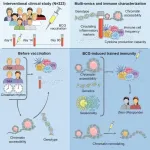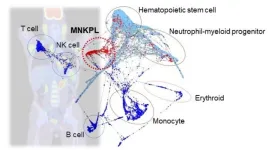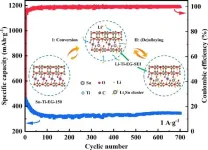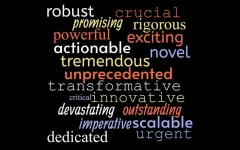(Press-News.org) Humans are protected by two branches of the immune system. Innate immunity provides built-in defense against widespread characteristics of bacteria and viruses, while adaptive immunity memorizes individual pathogens that a person has already encountered. Vaccines teach the adaptive immune system about new pathogens without having to go through an actual infection. This has greatly contributed to human health, but requires a specific vaccine for each major pathogen.
Some vaccines not only teach the adaptive immune system about a specific pathogen, but also increase the overall vigilance of our body’s innate immune cells. The BCG vaccine, which teaches our adaptive immune system to fight tuberculosis bacteria, has been shown to reduce infant mortality independent of its protection against tuberculosis. This observation can be explained by the concept of “trained immunity” – the idea that innate immune cells can switch between dormant and vigilant states, and are more effective at fighting infection when in their vigilant state.
Not every immune cell needs training
Inducing trained immunity by drugs or vaccines could confer protection in times of high infection risk, for example following a major surgery or during future pandemics before tailored vaccines become available. However, trained immunity is highly variable between individuals, and it is not well understood who may profit from inducing trained immunity.
To investigate this issue, a team led by Mihai Netea (Radboud University Medical Center) and Christoph Bock (CeMM & Medical University of Vienna) vaccinated 323 healthy volunteers with BCG and analyzed the effects on the immune system. They found that the induction of trained immunity was most effective in individuals with dormant innate immunity, which was reflected in a characteristic epigenetic cell state that predicted the vaccine response (Moorlag SJCFM, Folkman L, ter Horst R, Krausgruber T, et al. Immunity. 2024).
The team identified 213 individuals as trained immunity responders and 78 as non-responders, based on whether or not their production of inflammatory mediators had increased at day 90 after BCG vaccination – at a point when the acute response has subsided, but trained immunity is expected to persist. Trained immunity responders produced fewer mediators before vaccination and started with more dormant innate immune cells than non-responders. In other words, the non-responders already had the higher immune vigilance that the BCG vaccine induced in the responders.
Epigenetic regulation of immune balance
Both genetic and environmental factors contributed to this variability, but the most interesting differences were observed in the epigenetic states of the immune cells. Epigenetic cell states, implemented through changes in chromatin accessibility that make genes easier or harder to activate, reflect the regulatory plasticity of a cell and its ability to respond rapidly to changes in its environment, making them strong candidates for regulating trained immunity.
Indeed, in response to BCG vaccination, trained immunity responders gained open chromatin at genes involved in innate immunity, while non-responders carried such open chromatin independent of BCG vaccination, with no further increase following the vaccination. This finding explains how epigenetics allows immune cells to switch between different levels of immune vigilance, which contributes to the need to balance immune activity to provide protection against pathogens while avoiding unnecessary and harmful immune responses.
The study also clarifies a previously observed association between scar development at the site of BCG vaccination on the skin and lower child mortality. Previously, scar formation at the vaccine injection site was interpreted as a sign of a strong immune response to the vaccine. However, the team’s analyses offer an alternative explanation: it seems that scar formation reflects strong immunity prior to vaccination, and these individuals may be better protected against infections independent of BCG vaccination.
Enhancing immune vigilance
These results not only provide new insights into immune biology and the role of epigenetics, but also guide the development of future therapeutics. “We can envision a new class of drugs that deliberately wake up a dormant immune system,” Netea says. “Elderly people could receive a boost of their immune system prior to a planned hospital stay, and it may be possible to reactivate the suppressed immune system in patients with cancer. Several pharmaceutical companies are already pursuing ways to induce trained immunity without having to rely on the BCG vaccine.”
The new study provides important guidance for such endeavors. First, a better understanding of the biological pathways underlying trained immunity may uncover novel therapeutic targets. Second, the study shows that such therapeutics are only likely to benefit individuals with dormant innate immunity, who can be identified through chromatin profiling or functional immune assays. Third, no overshooting immune responses were observed in individuals with high innate immunity prior to vaccination, which bodes well for the safety of future trained immunity inducing drugs.
Bock summarizes: “Our study highlights the close connection between epigenetic cell states and trained immunity, allowing the human body to switch between vigilant and dormant innate immunity. This process is variable across individuals and may be exploited with precision medicine.”
+++
The study “Multi-omics analysis of innate and adaptive responses to BCG vaccination reveals epigenetic cell states that predict trained immunity” was published in Immunity on January 9, 2024. DOI: 10.1016/j.immuni.2023.12.005
Authors: Moorlag SJCFM*, Folkman L*, ter Horst R*, Krausgruber T*, Barreca D, Schuster LC, Fife V, Matzaraki V, Li W, Reichl S, Mourits VP, Koeken VACM, de Bree LCJ, Dijkstra H, Lemmers H, van Cranenbroek B, van Rijssen E, Koenen HJPM, Joosten I, Xu C-J, Li Y, Joosten LAB, van Crevel R, Netea MG#, Bock C# (* Contributed equally # Senior authors)
Funding: This study was supported by a Marie Skłodowska-Curie Actions Individual Fellowship (L.F.), an EMBO Postdoctoral Fellowship (R.t.H.), the European Research Council (M.G.N. and C.B.), the European Union’s Horizon 2020 research and innovation program (M.G.N. and L.A.B.J.), the Netherlands Organization for Scientific Research (M.G.N.), and two Austrian Science Fund Special Research Area grants (C.B.).
Christoph Bock is a Principal Investigator at the CeMM Research Center for Molecular Medicine of the Austrian Academy of Sciences and Professor of [Bio]Medical Informatics at the Medical University of Vienna. He is also the scientific coordinator of the Biomedical Sequencing Facility at CeMM, member of the Human Cell Atlas Organizing Committee, fellow of the European Lab for Learning and Intelligent Systems (ELLIS), and co-founder of a Vienna-based start-up company (Myllia Biotechnology). He has received major research awards, including an ERC Starting Grant (2016-2021), an ERC Consolidator Grant (2021-2026), the Otto Hahn Medal of the Max Planck Society (2009), the Overton Prize of the International Society for Computational Biology (2017), and the Erwin Schrödinger Prize of the Austrian Academy of Sciences (2022).
Mihai Netea heads the division of Experimental Medicine, Department of Internal Medicine, Radboud University Medical Center in Nijmegen. He is scientific founder of the biotech start-up companies Trained Therapeutix Discovery and Lemba, and of the biotech incubator Biotrip. He is mainly interested in understanding the memory traits of innate immunity (trained immunity) and has received major grants such as ERC Consolidator (2012-2017) and ERC Advanced (2019-2024). He is elected fellow of the Infectious Diseases Society of America, recipient of the van Loghem Award of the Netherlands Society of Immunology, and of the Spinoza Prize (2016). Since 2016 he is a member of the Netherlands Royal Academy of Sciences (KNAW).
The CeMM Research Center for Molecular Medicine of the Austrian Academy of Sciences is an international, independent and interdisciplinary research institution for molecular medicine under the scientific direction of Giulio Superti-Furga. CeMM is oriented towards medical needs and integrates basic research and clinical expertise to develop innovative diagnostic and therapeutic approaches for precision medicine. Research focuses on cancer, inflammation, metabolic and immune disorders, and rare diseases. The Institute's research building is located on the campus of the Medical University and the Vienna General Hospital.
www.cemm.at
The Medical University of Vienna is one of the most traditional medical education and research facilities in Europe. With almost 8,000 students, it is currently the largest medical training center in the German-speaking countries. With 6,000 employees, 30 departments and two clinical institutes, 13 medical theory centers and numerous highly specialized laboratories, it is one of Europe's leading research establishments in the biomedical sector. MedUni Vienna also has a medical history museum, the Josephinum.
www.meduniwien.ac.at
The Radboud University Medical Center is one of seven academic medical centers in the Netherlands. With ~11,100 employees it provides patient care, teaching (BSc and MSc medical and biomedical sciences, and postgraduate courses) and research. The center’s mission in scientific research is to advance human knowledge by conducting biomedical, translational and clinical research in order to improve wellbeing. Its key strength is medical life sciences and clinical practice, with an infrastructure comprising of state-of-the-art technology platforms and (translational) research facilities.
www.radboudumc.nl
For further information please contact:
Stefan Bernhardt
PR & Communications Manager
CeMM
Research Center for Molecular Medicine
of the Austrian Academy of Sciences
Lazarettgasse 14, AKH BT 25.3
1090 Vienna, Austria
Phone +43-1/40160-70 056
Mobile +43 660 3408133
sbernhardt@cemm.at
www.cemm.at
END
Vaccine boosts innate immunity in people with dormant immune cells
Epigenetic cell states predict whether or not an individual profits from the “wake-up call” to the innate immune system that is provided by the BCG vaccine
2024-01-09
ELSE PRESS RELEASES FROM THIS DATE:
New research shows mobile methadone units are most impactful in rural areas
2024-01-09
While mobile methadone units make a difference in expanding methadone use for patients with opioid addictions, they are likely to be most impactful in rural areas, according to new research.
The research was published today in Health Services Research and focused on the impact of adding new treatment services exclusively to rural Louisiana, where like in many other remote parts of the country, there are limited healthcare infrastructures and barriers to transportation. They compared this data to the impact of ...
PNNL kicks off multi-year energy storage, scientific discovery collaboration with Microsoft
2024-01-09
The urgent need to meet global clean energy goals has world leaders searching for faster solutions. To meet that call, the Department of Energy’s Pacific Northwest National Laboratory has teamed with Microsoft to use high-performance computing in the cloud and advanced artificial intelligence to accelerate scientific discovery on a scale not previously demonstrated. The initial focus of the partnership is chemistry and materials science—two scientific fields that underpin solutions to global energy challenges.
“The intersection of AI, cloud and high-performance computing, along with human scientists, we believe is key to accelerating the path to meaningful scientific ...
The hidden identity of leukemia
2024-01-09
Researchers from Tokyo Medical and Dental University (TMDU) use various technologies to better characterize a rare form of leukemia on the molecular level
Tokyo, Japan – Leukemia is a common term used to refer to a form of blood cancer. However, there are different types of leukemia depending on the cell type involved. One unique form is myeloid/natural killer (NK) cell precursor acute leukemia (MNKPL). Because of its rarity, there is no consensus on the specific characteristics needed to clinically identify this disease. In a recent article ...
Unique framework of tin bimetal organic compound facilitates stable lithium-ion storage
2024-01-09
Battery capacity is one of the primary bottlenecks in efficient renewable energy storage and significant reductions in carbon emissions. As a battery anode that releases electrons in a lithium-ion battery (LIB), tin (Sn) and Sn-mixture alloys could theoretically store more energy at a higher density than more common carbon-based anodes. Pairing a Sn-Ti bimetal element with inexpensive ethylene glycol (Sn-Ti-EG) mitigated many of the challenges of using Sn as an anode material and produced an inexpensive LIB with excellent storage and performance characteristics.
Sn and Sn alloys, or mixture of another metal with Sn, could outperform other anode materials ...
Attribution of the extreme drought in eastern China in 2022 and its future risk
2024-01-09
Eastern China was hit by an extreme drought in summer 2022 that caused severe economic and agricultural damage. The event has attracted a great deal of attention not only because of its severe intensity and huge social impacts, but also because it is yet another example within the hot topic of the influence of anthropogenic forcing induced warming on drought extremes and how they might change under different scenarios of continued warming in the future.
Recently, Atmospheric and Oceanic Science Letters published ...
Increasing levels of "hype" language in grant applications and publications
2024-01-09
Tsukuba, Japan—The success of scientific endeavors often depends on support from public research grants. Successful applicants increasingly describe their proposed research using promotional language ("hype"); however, it remains unclear whether they use hype in their subsequent research publications.
A research team led by the University of Tsukuba analyzed all published research abstracts of projects funded by the US National Institute of Health (NIH) from 1985 to 2020. The analysis covered 139 hype adjectives emphasizing significance ...
Is spa water a fossil of water? Uncover the real ultra-deep water cycles
2024-01-09
Tsukuba, Japan—Although most natural spa waters primarily originate from atmospheric precipitation, such as rain and snow (known as meteoric water), the present study explored the unique qualities of certain spa waters. By analyzing the stable isotope compositions of hydrogen and oxygen in water molecules, researchers have identified distinct characteristics that indicate the presence of long-trapped lithospheric water. They traced the isotopic evolution of this water through sophisticated numerical modeling, and found that various types of water, including those found deep beneath the ...
Light measurement enables estimation of the chemical attributes of spice extracts
2024-01-09
Tsukuba, Japan—Spices and other plant-derived products contain many active components, such as polyphenols and flavonoids. However, even the slightest variations in conditions can considerably affect the extraction efficiency of these active components, posing challenges in determining the exact quantity of active components in the extract solution.
In this study, researchers comprehensively measured the fluorescence emitted by polyphenols and flavonoids and analyzed the acquired data using machine learning methods. ...
Nemours Children’s Health researchers find Zika virus is effective when used to treat a type of childhood cancer in mice
2024-01-09
ORLANDO, Fla. (Jan. 9, 2024) — Injecting neuroblastoma tumors with Zika virus shrank or eliminated those tumors in studies with mice, suggesting that the virus could someday serve as an effective cancer therapy, according to a study led by Nemours Children’s Health researchers and published today in Cancer Research Communications, a journal of the American Association for Cancer Research.
Neuroblastoma is a rare childhood cancer that typically develops in the sympathetic nervous system or the adrenal glands. Only 700 to 800 cases are diagnosed each year in the United States, accounting for ...
Multidisciplinary panel advocates for increased adoption of Intravascular Ultrasound (IVUS) in peripheral vascular interventions
2024-01-09
EMBARGOED UNTIL 10:00 AM ET ON JANUARY 9, 2024
WASHINGTON (January 9, 2024) – Proceedings from an expert consensus roundtable that discussed the benefits of intravascular ultrasound (IVUS) in lower extremity revascularization procedures were released today in the Journal of the Society for Cardiovascular Angiography & Interventions (JSCAI), Journal of Vascular and Interventional Radiology (JVIR), and Journal of Vascular Surgery - Vascular Insights.
The roundtable focused on the current challenges in diagnosing ...
LAST 30 PRESS RELEASES:
Numbers in our sights affect how we perceive space
SIMJ announces global collaborative book project in commemoration of its 75th anniversary
Air pollution exposure and birth weight
Obstructive sleep apnea risk and mental health conditions among older adults
How talking slows eye movements behind the wheel
The Ceramic Society of Japan’s Oxoate Ceramics Research Association launches new international book project
Heart-brain connection: international study reveals the role of the vagus nerve in keeping the heart young
Researchers identify Rb1 as a predictive biomarker for a new therapeutic strategy in some breast cancers
Survey reveals ethical gaps slowing AI adoption in pediatric surgery
Stimulant ADHD medications work differently than thought
AI overestimates how smart people are, according to HSE economists
HSE researchers create genome-wide map of quadruplexes
Scientists boost cell "powerhouses" to burn more calories
Automatic label checking: The missing step in making reliable medical AI
Low daily alcohol intake linked to 50% heightened mouth cancer risk in India
American Meteorological Society announces Rick Spinrad as 2026 President-Elect
Biomass-based carbon capture spotlighted in newly released global climate webinar recording
Illuminating invisible nano pollutants: advanced bioimaging tracks the full journey of emerging nanoscale contaminants in living systems
How does age affect recovery from spinal cord injury?
Novel AI tool offers prognosis for patients with head and neck cancer
Fathers’ microplastic exposure tied to their children’s metabolic problems
Research validates laboratory model for studying high-grade serous ovarian cancer
SIR 2026 delivers transformative breakthroughs in minimally invasive medicine to improve patient care
Stem Cell Reports most downloaded papers of 2025 highlight the breadth and impact of stem cell research
Oxford-led study estimates NHS spends around 3% of its primary and secondary care budget on the health impacts of heat and cold in England
A researcher’s long quest leads to a smart composite breakthrough
Urban wild bees act as “microbial sensors” of city health.
New study finds where you live affects recovery after a hip fracture
Forecasting the impact of fully automated vehicle adoption on US road traffic injuries
Alcohol-related hospitalizations from 2016 to 2022
[Press-News.org] Vaccine boosts innate immunity in people with dormant immune cellsEpigenetic cell states predict whether or not an individual profits from the “wake-up call” to the innate immune system that is provided by the BCG vaccine






